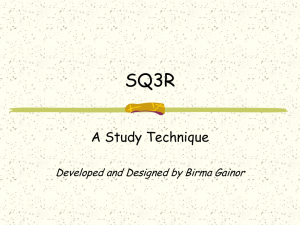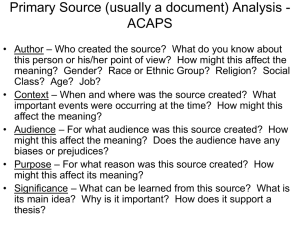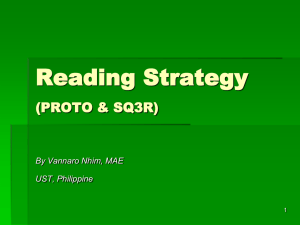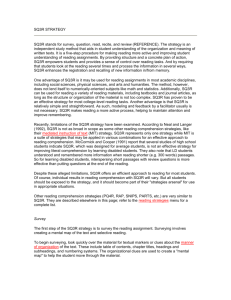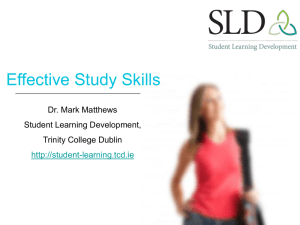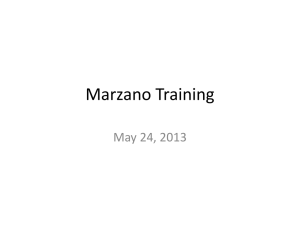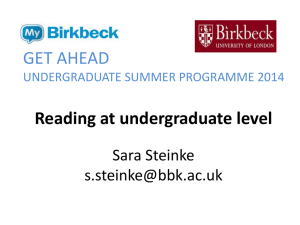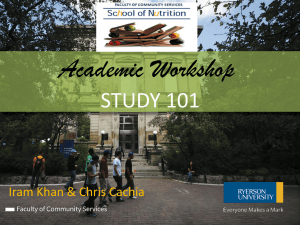Reading & Marking Textbooks
advertisement
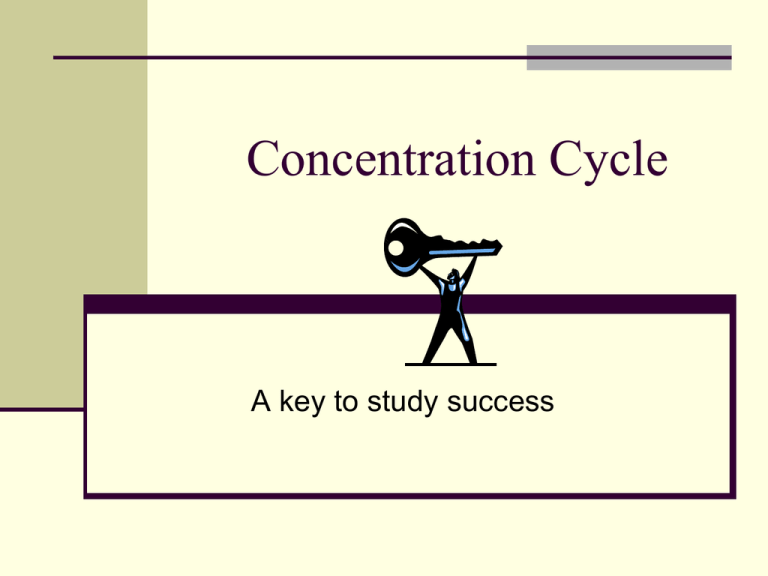
Concentration Cycle A key to study success Learning Pyramid Average Retention Rate Lecture Less Reading Audio/Visual Demonstration Discussion Group Practice by Doing Teach Others/Immediate Use of Learning Source: National Training Laboratories – Bethel, Maine More Barriers to Concentration Hunger Fatigue Distractions (What are your distractions?) Where do you study? How do you prepare to study? What is on your mind? Building Concentration Develop an interest and positive attitude What is one thing you can learn? Set a specific study goal “I’m going to take reading notes on pgs. 38-62” instead of “I’m going to read my Sociology text.” Set specific study times during the week. (weekly planner) Prepare to study: Gather appropriate study materials. Dump your distractions – write them down. Attend to physical needs beforehand (eat, drink, exercise). Plan rewards! Building Concentration Appropriate time and place Don’t study where you eat or sleep. Study when you have the most energy. Are you a morning person? Are you a night owl? Building Concentration What is the task? Organize the assignment. Vary the activity. Prevent daydreaming: ideas? Relate learning: practical application Pace yourself: 50 min. study 10 min. break What do you think about this student’s studying? Concentration Cycle 10 min. Study Break Begin Study Period Light (about 5 min.) Moderate (about 5 min.) Ideal Study Session Deep (about 40 min.) Active reading strategies Make friends with your textbooks Reasons college students don’t read their (expensive) textbooks Past experience: I didn’t have to in high school, and I still got A’s and B’s. Specialized, technical information Hard to understand Difficulty retaining information Boring Motivation factors Active Reading Strategies to avoid MEGO My eyes glaze over "Reading is a means of thinking with another person's mind; it forces you to stretch your own." Charles Scribner, Jr. Making the CAASE for you to become a critical reader In all of your roles: school, job/career, community member, family/personal With all types of material: books, newspapers, magazines, advertisements, marketing, Internet You need to be able to CAASE: Comprehend what you read. Apply what you learn from what you read. Analyze what you read for accuracy, credibility. Synthesize what you read from multiple sources. Evaluate what you read so you can use it in making decisions . Wow, can anyone say “Bloom’s”?? Active Reading Before During After Sound familiar? Yup! Same concept as note taking. What do you do before, during, and after reading textbook material? Active Reading Before: During: comprehension strategies Use a reading system. PBID: assess and select reading strategies. Surveying, pre-reading Finding the main ideas and important details Annotating: summarizing important information You’ve already learned this! Just like Split Page, T method, etc. After: Reviewing what you read to prepare for tests Creating additional study guides (written rehearsal strategies; visual organizers) Why do I need a reading system? You don’t. IF you don’t care about being able to comprehend or use what you read. Oh, so you do care most of the time? Great! A reading system will help you: Stay active while reading. Identify important information for test preparation. Increase your comprehension. Increase your ability to remember and retain information. SQ3R reading system Survey Question Read Recite Review BEFORE DURING AFTER Many types of reading systems. All have 3 things in common: 1. Previewing before you read 2. Marking & taking notes while reading 3. Reviewing after what you read SQ3R Before PBID technique If you don’t know where you are going, how will you know when you arrive? Purpose: Why am I reading this material? Background: What do I already know about the subject? Interest: How interested am I in this subject? Difficulty: How difficult is the text or article? SQ3R Before PBID ● A great “BEFORE/SQ” activity. ● Like stretching before exercise; warms you up ● Helps you select the reading strategies you will need to understand the material ● Improves your efficiency and speed Instructors: demonstrate this with your students for their first chapter. SQ3R Before PBID demonstration Using your ____textbook, Chapter __: 1. Do a PBID and turn it in. Instructors: broadcast or online, you could craft this as an assignment for 5 points. SQ3R Before Movie and book previews Survey Set context to help understand plot Big picture so you can fit in the details Improves comprehension Previewing text book material: Why? How? SQ3R Before guided tour for your students. Help them learn the “architecture”. Pre-chapter guides Survey (preview):demo your text book. Give a Chapter title, introduction, pre-questions, objectives, glossary What’s unique about our textbook? Within chapter guides Headings, graphics, diagrams, bold & italic print, vocabulary What else does ___textbook have? Post chapter guides Summary, chapter questions, other? SQ3R Before Question: Chapter 9 How does creating questions before you read help comprehension? Instructors: demo this with your textbook SQ3R Before Survey/Question exercise Create an outline of pages 144-149 of Chapter 9. (written survey) Create at least three questions as you outline. (Who? What? Why? Where? When? How?) Explicit practice for what you would normally do silently/visually Written outlines can be used to take reading notes if you don’t want to mark in textbook (example to get you started) Active Reading Ch. 9 1. Strategies for Warming Up for Reading (pg. 147 heading) A. Create a good learning environment. (heading bold) 1. noise level (numbered;bold) (Q: What will it say about playing music while I study?) 2. learning space (numbered;bold) (Q: How can I best organize my study area? Finish outlining on your own. Active Reading Before: During: comprehension strategies Use a reading system PBID: assess and select reading strategies Surveying, pre-reading Finding the main ideas and important details Annotating: summarizing important information You’ve already learned this! Just like Split Page, etc. After: Reviewing what you read to prepare for tests Creating additional study guides SQ3R Read: Finding the main idea During What can you take away from this food item and still maintain the “essence” of what it is? Is it still a hamburger without pickles? Cheese? Onions, lettuce, sauce? SQ3R During Finding the main idea All of those items help make the hamburger tasty, but they don’t define it as a hamburger. Without the “two all beef patties” and buns, you don’t have a hamburger. Meat and buns = main idea of a hamburger Pickles, etc. = supporting details Many students struggle identifying main ideas, which affects their comprehension. SQ3R During Finding the main idea Main idea Main idea Topic = Subject of paragraph + Controlling Idea what we learn about the subject in the paragraph SQ3R During Finding main idea: example Instructors: come up with several examples from your textbook to help students. Show them on doc camera or in a PowerPoint (for online courses) SQ3R During Finding main idea: example To many parents, the infant’s crying may be mainly an irritation, especially if it continues for long periods. But crying serves important functions for the child as well as the parents. For the child, crying helps improve lung capacity and the respiratory system. Perhaps more important, the cry serves as a signal of distress. When babies cry, they indicate that they are hungry or in pain, and this is important information for parents. Infant crying A. Serves important functions 1. improves lung capacity and respiratory system 2. signals distress a. hunger b. pain SQ3R Finding the main idea During Main idea Main idea Topic = Crying (of infants) Controlling Idea + serves important functions for child & parents SQ3R Main idea: practice #1 During Despite the hatred that most people feel toward cockroaches, they do help humans in several ways. For example, they are perfect experimental animals and are used for scientific research in the laboratory. Breeding them is easy, for they thrive under almost any conditions. In studies on nutrition and food, cockroaches are good subjects because they will eat any kind of food. They can be used to study heart disease, and cancer researchers work with roaches because they grow cancerous tumors like those that are found in humans. Main idea: What is the topic/subject of paragraph? What do we learn about the topic? (controlling idea) SQ3R Main idea practice #1 During Despite the hatred that most people feel toward cockroaches, they do help humans in several ways. For example, they are perfect experimental animals and are used for scientific research in the laboratory. Breeding them is easy, for they thrive under almost any conditions. In studies on nutrition and food, cockroaches are good subjects because they will eat any kind of food. They can be used to study heart disease, and cancer researchers work with roaches because they grow cancerous tumors like those that are found in humans. Main idea is in first sentence. SQ3R During Marking = identifying main ideas (underline or highlight) Annotating = making notes to condense and summarize Read: Marking and Annotating Just like the note taking methods. You already can do this. Just do it with your text books. You bought your textbooks; you can write in them. Writing in textbooks does not affect buy-back. SQ3R During Methods for marking your text Read, think, decide, AND THEN mark! What is important? Highlight or underline Left to right (built in re-read) Number any causes, effects, characteristics, factors, etc. K.I.S.S. Don’t become too complex in your system SQ3R During What to Mark? ** Guideline: If it might be on the test, mark it! ** Mark main ideas Topic/subject and what is said about the topic in (controlling idea) Usually 1st or 2nd sentence of paragraph Remember: can be stated or implied. Mark supporting details SQ3R During What to mark? Mark information that answers purposesetting questions Mark enough so that 1 month later the information will make sense! Avoid under- OR over-marking SQ3R During “Three Bears” rule Too much Outlines and maps help you predict and organize information while surveying. This is particularly true if you rephrase headings and subheadings into questions or connect chapter titles with headings and subheadings to questions. Questions require you to look for answers, and thus, make reading more active. You read to answer what, how, when, who, which, where, and why. When previewing, you will normally be looking for main ideas. Thus, why, how and what questions will form the basis of your previewing outline. Question outlines and maps make previewing less covert and more concrete. They help set goals for reading. SQ3R During Too little Outlines and maps help you predict and organize information while surveying. This is particularly true if you rephrase headings and subheadings into questions or connect chapter titles with headings and subheadings to questions. Questions require you to look for answers, and thus, make reading more active. You read to answer what, how, when, who, which, where, and why. When previewing, you will normally be looking for main ideas. Thus, why, how and what questions will form the basis of your previewing outline. Question outlines and maps make previewing less covert and more concrete. They help set goals for reading. SQ3R During Just right Outlines and maps help you predict and organize information while surveying. This is particularly true if you rephrase headings and subheadings into questions or connect chapter titles with headings and subheadings to questions. Questions require you to look for answers, and thus, make reading more active. You read to answer what, how, when, who, which, where, and why. When previewing, you will normally be looking for main ideas. Thus, why, how and what questions will form the basis of your previewing outline. Question outlines and maps make previewing less covert and more concrete. They help set goals for reading. SQ3R During Annotating your text (making reading notes) Develop your own system, as long as it Identifies main ideas, supporting details Increases your comprehension Provides effective study/review guide And, you will still be able to sell your books! Why is it not effective to use someone else’s annotations (like in a used textbook)? SQ3R During Example of annotation Instructors: Create an example from your textbook or other required reading materials. Upload to Blackboard and/or show on doc cam. Show an example from your course reading material or text. SQ3R After Recite & Review is Essential! Review what you marked and annotated. Recite aloud when necessary. Think about what information could be on a test. Create visual organizers to help you with test prep Concept cards: terms, definitions Charts, diagrams: processes, procedures, cycles, systems, comparisons Review and answer the questions you developed during survey/question phase. Think of other questions your prof. could ask on a test.
